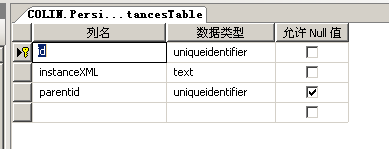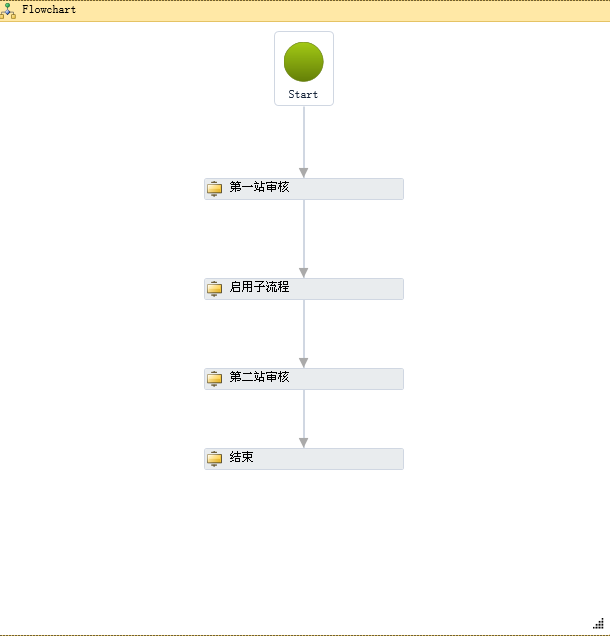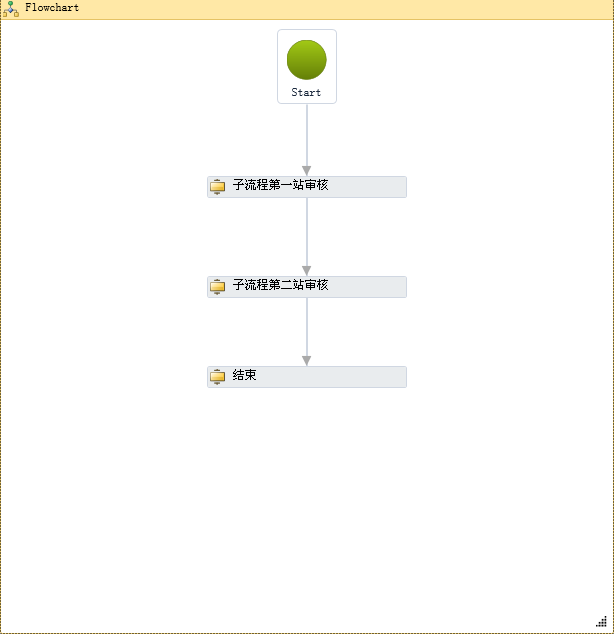工作流服務中,經常會在主流程啟用一些子流程。我在審批流程中經常會使用bookmark來暫停流程,這篇文章,將結合bookmark來實現主流程啟動子流程。
使用以前的一篇WF4.0自定義持久化中的自定義的持久化。不過數據表中加入了一個字段parentid,用於標識父流程:

下面用一個流程實例為例說明主流程是如何啟用子流程,子流程又是如何返回主流程的,主流程如下:

第一個節點“第一站審核”和第三個節點“第二站審核”都是BookMark書簽,附BookMark的代碼如下:
代碼
public sealed class Read<TResult> : NativeActivity<TResult>
{
public Read()
: base()
{
}
public string BookmarkName { get; set; }
// Define an activity input argument of type string
public InArgument<string> Text { get; set; }
// Must return true for a NativeActivity that creates a bookmark
protected override bool CanInduceIdle
{
get { return true; }
}
protected override void Execute(NativeActivityContext context)
{
context.CreateBookmark(this.BookmarkName, new BookmarkCallback(this.Continue));
}
void Continue(NativeActivityContext context, Bookmark bookmark, object obj)
{
this.Result.Set(context, (TResult)obj);
}
第二個節點“啟用子流程”,它是一個自定義的節點,代碼如下:
代碼
public sealed class CallChild : Activity
{
public string FlowName { get; set; }
public CallChild()
{
base.Implementation = new Func<Activity>(CreateBody);
}
public Activity CreateBody()
{
return new Sequence
{
DisplayName = "子流程",
Activities =
{
new ChildCodeActivity
{
FlowName=this.FlowName
}
,
new Read<string>
{
BookmarkName="CallChild",
}
}
};
}
}
注意上面的ChildCodeActivity類,實際上是在ChildCodeActivity中啟動子流程的,ChildCodeActivity後面是一個書簽,用於暫停主流程。當子流程完成後,在子流程中恢復這個書簽,子流程結束,主流程繼續往下跑。這個活動中有一個FlowName屬性,用於表示是啟用哪個子流程。ChildCodeActivity代碼如下:
代碼
sealed class ChildCodeActivity : CodeActivity
{
// Define an activity input argument of type string
public string FlowName { get; set; }
// If your activity returns a value, derive from CodeActivity<TResult>
// and return the value from the Execute method.
protected override void Execute(CodeActivityContext context)
{
Guid ChildGuid;
ChildGuid = WorkFlowRun.CreateAndRun(FlowName);
InstancesTable obj = InstancesTableBiz.GetInstancesTable(ChildGuid);//取得子流程的id
obj.parentid = context.WorkflowInstanceId;
InstancesTableBiz.UpdateInstancesTable(obj);//跟新父流程id
}
}
WorkFlowRun.CreateAndRun(FlowName)根據FlowName啟動相應的子流程,並得到實例的Guid。並將子流程的parentid修改改成主流程的guid。
子流程的示例如下:

子流程的第一個節點“子流程第一站審核”和第二個節點“子流程第二站審核”也都是BookMark書簽。
最後一個節點是“結束”。這個節點也至關重要,因為我是使用這個節點,從子流程中返回到主流程的。因此,每個子流程都會有End節點,它的代碼如下:
代碼
public sealed class End : CodeActivity
{
// Define an activity input argument of type string
public InArgument<string> Text { get; set; }
// If your activity returns a value, derive from CodeActivity<TResult>
// and return the value from the Execute method.
protected override void Execute(CodeActivityContext context)
{
// Obtain the runtime value of the Text input argument
string text = context.GetValue(this.Text);
Guid id = context.WorkflowInstanceId;
InstancesTable Obj = InstancesTableBiz.GetInstancesTable(id);
if (Guid.Empty != Obj.parentid)//如果是子流程,返回父流程
{
WorkFlowRun.Submit(Obj.parentid, "ParentProcess", "returnMain");
}
}
}
這是我思考出的在WF4.0中一個啟用子流程的方案,如果你有什麼更好的方案和建議,請給我留言,謝謝。
出處:http://zhuqil.cnblogs.com